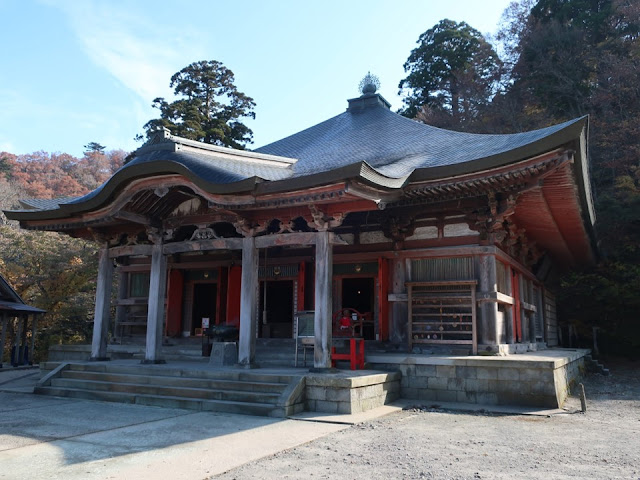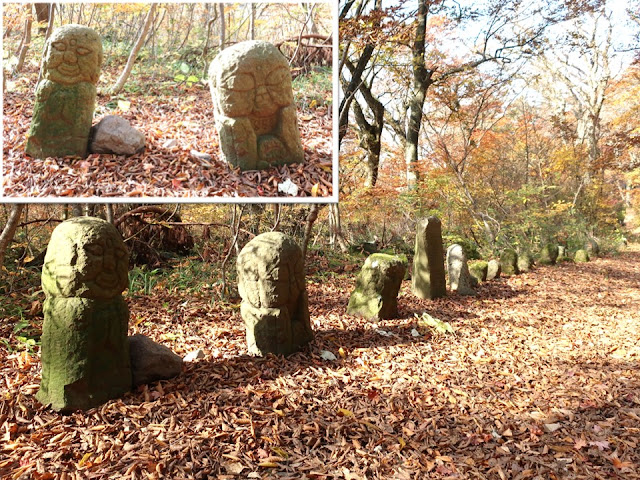Mt. Daisen (1709 m) is in Tottori Prefecture, which shape from the north side is gentle. However, it’s south side is rocky; the photos are at the bottom of this article.
スキーもできる鳥取県の名峰・大山(1709m)。北側から見た大山はやさしい山です(岩肌の南側の写真は記事の最後にあります)。
The large museum is on the mountainside and is at beside the approach to Daisen-ji (temple).
大山自然歴史館は、大山の中腹、大山寺への参道にある鳥取県立の巨大施設です。
The panel near the entrance hall is named “Thanks to Daisen-san”. Because Mt. Daisen’s rich nature gives people agricultural and livestock products, and seafoods. Moreover, Jizo Bodhisattva is said to have appeared at the top of the mountain.
まず、「大山さんのおかげ」という大型パネルがあります。山頂に現れたという地蔵菩薩への信仰、そして自然、農畜産物、海産物まで大山さんのおかげということです。
Various creatures in Mt. Daisen shows its rich nature, which makes our life rich, too.
大山に暮らす様々な生き物。自然が豊かだと暮らしも豊かになりますね。
“Daisen Historical Picture Scroll” shows the worship in Mt. Daisen and that many worshipers have come. The temple was established in 718. Locals enshrined Jizo Bodhisattva and started ascetic practices.
大山歴史絵巻。このコーナーで大山信仰、大山の賑わいがよく分かります。718年の開山。玉造の人が仏縁を得て、大山で地蔵菩薩を祀り、修行を始めました。
It says, “Around the 12th century, the Daisenji temple complex was headed by three main temples.” There were one-hundred eighty temples and three thousand monks who were also soldiers. So, they had great influence. However, they sometimes battled. Many temples are depicted in the picture which is exhibited in Daisen-ji Reihou-kaku.
12世紀頃、大山には三院あり、合計で僧坊が180、僧兵が3000人もいました。一大勢力ですが抗争を繰り返しました。大山の絵地図(大山寺・霊寳閣)にはたくさんの寺院が描かれています。
The spring festival at Daisen-ji is shown by paper dolls. There are two potable shrines which head to the temple and people who join the cattle and horse market.
「大山寺春祭り」という紙人形です。お寺に向かう神輿(御幸行列/みゆきぎょうれつ)が右側に、左下では牛馬市が表現されています。祭りと牛馬市、関係があったのですね。
It is written, “When visiting Daisen-ji temple, people sometimes took cattle or horses to carry food or tributes. People believed the Jizo of Daisenji temple were guardian gods of those animals, so many cattle and horses were taken there for a blessing as well as for practical use.” Then, people started to compare their cattle or horses. It was the origin of the market. In around 1726, the cattle and horse market began officially. “The Daisen cattle and horse market became the biggest in Japan selling 10,000 head of cattle and horses in a year.”, it says.
牛馬市は、大山寺の祭りなどの折に、大山山麓で育った体格の良い牛馬と参詣者の牛馬を比べる牛くらべ・馬くらべが始まりでした。自然発生的な娯楽ですね。
参詣者は食料やお供えを運ぶために牛馬を伴うことがありました。また、大山の地蔵菩薩は牛馬の守護神といわれていたため、そのご加護にあずかろうと多くの牛馬が集まってきたのです。
鎌倉時代以降、牛馬市に発展し、1726年頃から大規模な市になり、年間1万頭が売買される日本最大の市になりました。牛馬市は、1936年まで続けられました。左の男たち、取引が成立したのか嬉しそうです。日本遺産になっています。
The parking area was a venue of Daisen cattle and horse market “Bakurou-za”. The monitor on the left shows us an AR(Augmented Reality)image of the market. We can see the stalls, merchants, cattle and horses on the screen. And we can know their conversations. It's interesting.
大山自然歴史館の前の駐車場が、牛馬市の会場「博労座」でした。モニターではAR(Augmented Reality)で駐車場に小屋や人、牛馬を映し出し、会話も分かるようにしています。この場所でねえ。
Daisen-ji (temple)、大山寺
I walked to the temple through the approach which faces to the museum. There are several inns for worshippers.
大山自然歴史館の横から大山寺への参道を登っていきました。参道に沿って宿坊が数軒あります。
It’s a beautiful season of autumn leaves.
紅葉が美しかったですね。
In Reihou-kaku, not only Buddhist statues which are designated as cultural assets but also utensil used for serving and drinking sake (alcohol, upper left) are exhibited.
霊寳閣には、文化財に指定されている仏像だけでなく、上質な酒器(左上)もありました。
There are stone Buddhist statues beside the road. Their faces are tender; they have watched worshippers.
道ばたにやさしいお顔の石ぼとけさまが並んでいました。参拝者を見守ってきたのでしょうね。
I drove to Kagikake-pass to see the southside of Mt. Daisen. The view is totally different from it from the northside.
大山寺から車で鍵掛峠へ行きました。大山南壁、南側から見る大山は全く異なる顔です。
The view from Monju-dou made me felt the power of the nature.
文殊堂からの大山。自然の力を感じます。
Visited in November, 2022
Official website: http://daisen-museum.jp/ (in Japanese), accessed in May, 2023
Previous post (museum in the neighboring
prefecture): Matsue Horan enya Memorial Hall、松江ホーランエンヤ伝承館
Next post (museum in the same prefecture): Tottori Prefectural Museum、鳥取県立博物館

















Comments
Post a Comment